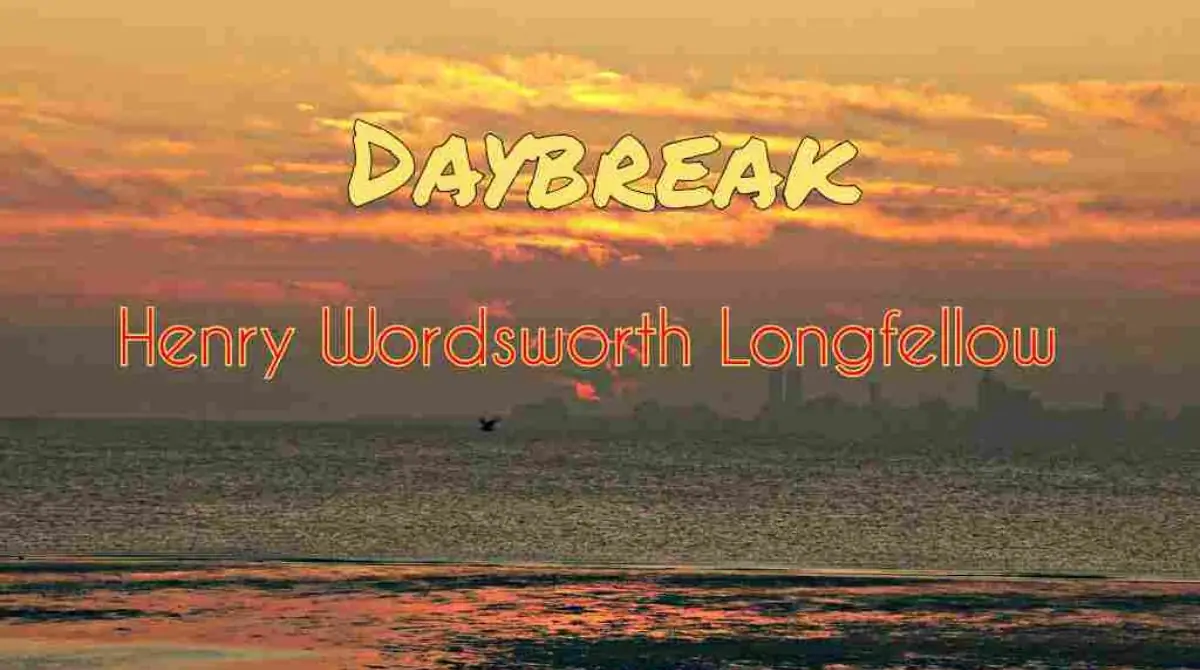Questions Answers of the Poem Daybreak
Here is the detailed study of the poem Daybreak by H.W. Longfellow. Click on Play button of the video below and study the poem.

Questions Answers from the poem Daybreak
1) How does the poet personify the wind in the poem ,”Daybreak”?
Ans: The poet, H.W. Longfellow had used a number of personification in the poem, “Daybreak” to make the subject matter more lively and vivid. The wind is a natural force. But the poet has imagined the wind as a living being and has entrusted the wind with the task of proclaiming the approach of a new day. The poet has given dialogue in the mouth of the wind.
The wind is the speaker from the very beginning upto the end of the poem. Not only the wind but also many inanimate objects like fields of corn, belfry tower are also personified in the poem. In fact, the wind plays the role of messenger of the poet. As a new dawn is on the threshold, the poet wants to convey a welcome message to a new age of activity, justice and peace. There is also a metaphorical comparison in ‘leafy banners’.
The unfurled leaves act as banners bearing messages of bright millennium. In this way, the literary devices help to fulfill the purpose of the poet to bring out his optimism towards life.
2) What role does the wind play in the poem “Daybreak”?
Ans: In the poem “Daybreak”, H.W. Longfellow has presented the wind as a herald of a new day and a new age as well. The wind plays the role of a messenger to both animate and inanimate objects on earth. The poet actually puts his own words into the lips of the personified wind. Rising from the sleepy sea, it tells the mists to make way for it. It moves towards inland carrying the message to severe all kinds of outdated customs, superstitions, injustices, unrest and to wake with renewed energy and enthusiasm.
It invokes the mariners to rise from sleep and start their voyage. Then it blows through the forest and asks forest to unfurl all leaves like banners inlaid with hopeful messages. It persuades the wood bird to herald the dawn through its songs. While crossing the farms, the wind asks the house-cock to blow clarion to proclaim the hour. It urges the fields of corns to bow heads to welcome the bright sun.
It asks the church bell to ring in the supreme moment of sunrise. But when it moves across the churchyard, it sighs for the dead and asks them to lie quietly and enjoy the sleep of eternity.
3) Write a note on the significance of the title of the poem “Daybreak”?
Ans: The poem “Daybreak” is written in nine lovely rhythmic couplets. The title of H.W. Longfellow’s poem is “Daybreak”. Normally daybreak means the beginning of a day. It indicates the time of dawn. In the poem we seem to move on from the sea to inland, forest, churchyard with the wind at the starting of a day. The darkness of night disappears.
A wind rises from the sleepy sea takes the responsibility to proclaim the beginning of a new day as well as new millennium with hopeful rays of rising sun. The poet has wonderfully caught the mood and atmosphere of the earth at “Daybreak” and imaginatively personified the wind to awake every animate and inanimate objects to do their respective duties.
So the title of the poem “Daybreak” not only indicates the starting of a day; but also the word “Daybreak” is a clarion call for activity and action. The title of the poem wonderfully echoes the mood and theme of the poem i.e to “hail the coming morn”. So the title is quite appropriate.
4) “It crossed the churchyard with a sigh, And said, Not yet! in quiet lie” — What does the concluding lines of the poem, “Daybreak” suggest?
Ans: A wind rises up out of the sea when the sun comes out after the sleepy night. It moves towards the inland unveiling the mist in its way. Then the wind meets the sailors of ships, the forest, the wood-bird, the chanticleer, the corn-field, the church-bell one by one. The wind conveys the message of new dawn to all of them and urges to start their activities and welcome the new dawn with renewed energy. It asks the church bell to ring to proclaim the supreme moment of sunrise.
But when the wind passes through the churchyard it tones down and minimises its motion. It heaves a sigh of grief for those who are lying dead peacefully under the graves. The wind does not want to disturb their sleep. They should enjoy the eternal sleep. They need not to be awakened as the time has not yet come for them to wake up. It refers to the Christian belief. According to the New Testament of the Bible, there is a belief that the dead buried in churchyard will rise only at the time of Judgement Day when Jesus will appear to judge the universe.
You May Like To Read More:
